Hasan Padamsee surveys developments in a key technology.

In a seminal paper published in June 1961 A P Banford and G H Stafford described how a future superconducting proton linear accelerator could run continuously, instead of at the 1% duty cycle of the 50 MeV proton accelerator that was operating at the time at the Rutherford High Energy Laboratory in the UK. The basic argument was that, because ohmic losses in the accelerating cavity walls increase as the square of the accelerating voltage, copper cavities become uneconomical when the demand for high continuous-wave (CW) voltage grows with particle energy. It is here that superconductivity comes to the rescue.
The RF surface resistance of a superconductor is five orders of magnitude less than that of copper. The quality factor (Q0) of a superconducting resonator is typically in the billions (i.e., a billion oscillations before the resonator energy dissipates). After accounting for the refrigerator power needed, the net gain in the overall cooling power remains a factor of several hundred. It became clear that the higher-voltage, shorter superconducting structures can also reduce the disruptive effect that accelerating cavities have on the beam, resulting in better beam quality, higher maximum current and less beam halo (less activation). By virtue of low losses in the walls, a superconducting RF (SRF) cavity design can also afford a large beam aperture, which further reduces beam disruption and beam halo.
It took nearly 40 years for the early dream of that high duty-factor, high-intensity proton linear accelerator to be fulfilled. Today, the Spallation Neutron Source (SNS) at Oak Ridge National Laboratory runs at 6% duty cycle with 88 m of superconducting cavities providing 1 MW of beam power with a 1 GeV, 10 mA beam. The success of the SNS has stimulated the construction of the European Spallation Source (ESS), with 5 MW of beam power, to be completed in 2016.
Pioneering work
In the early 1960s, Stanford University, under the leadership of William Fairbank, pioneered the development of superconducting cavities for electron accelerators. By 1968 they achieved a Q value of more than 1010 at 1.7 K for an 8.5 GHz TM010-mode single-cell pill-box resonator built of solid niobium. The first niobium cavity also demonstrated the exciting prospect of gradients of more than 30 MV/m.
However, with the more practical, lower frequency (1.3 GHz) accelerator structures that were built in the 1970s, the performance level fell to 2–4 MV/m. The primary roadblock was multipacting – the spontaneous resonant production of electrons. By the mid-1980s, the physics of multipacting was understood. It turned out that the limiting field-levels scale with the RF frequency, so the high-frequency cavities of the 1960s had been fortuitously exempt.
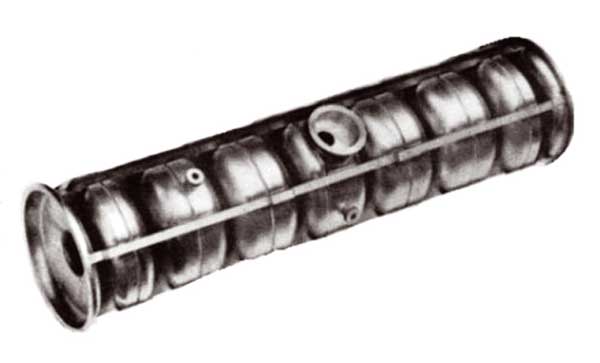
Image credit: Courtesy H Padamsee.
The next three decades saw several layers of gradient problems being uncovered, the underlying physics understood and solutions developed. Cavity performance then ratcheted up at a steady pace, as did accelerator applications. The development of the anti-multipacting, spherical (and elliptical) cavities was a breakthrough moment. With multipacting overcome, thermal breakdown of superconductivity became the next limiting mechanism, at 4–6 MV/m. Local heating at surface imperfections led to thermal runaway and a quench of superconductivity. The cure was to switch to niobium of high-purity – high residual-resistance ratio (RRR) niobium. With the co-operation of industry, RRR improved by an order of magnitude and cavity gradients rose on average by a factor of three. Another cure for thermal breakdown was to sputter a micron-thin film of niobium onto a copper cavity-substrate, which also had the benefit of reduced material costs – especially for the cavernous, low-frequency (0.35 GHz) cavities.
With the corresponding rise in surface electric fields, electron emission became the next limit to gradients, at 10–15 MV/m. Global R&D revealed microparticle contamination to be the dominant source of field emission, so the solution demanded better preparation techniques, such as powerful surface scrubbing with high-pressure (100 atm) water and assembly in Class 100 clean rooms. With these advances, cavity gradients climbed to 20 MV/m.
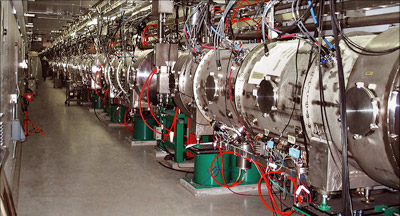
Image credit: ORNL.
Above 20 MV/m, however, RF losses began mysteriously to rise exponentially with the field. The physics of such losses is still under investigation but pragmatic countermeasures are already in place. Electro-polishing has replaced the standard chemical etching to obtain a smoother surface, followed by mild baking at 120 °C for two days. There is now excellent prognosis for reaching 35–40 MV/m. Many nine-cell, 1 m-long niobium structures have demonstrated performance above 40 MV/m in qualification tests, while basic research continues to push towards the theoretical limit of 55 MV/m.
SRF takes off
As gradients improved steadily from the mid-1980s, RF superconductivity grew into a key technology for accelerators at the energy and luminosity frontiers, as well as at the cutting edge of low- and medium-energy nuclear physics, nuclear astrophysics and basic materials science. SRF cavities are now routinely accelerating electron, proton and heavy-ion beams in a variety of frontier accelerators.
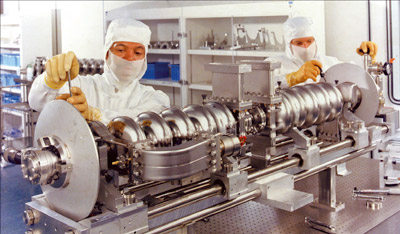
Image credit: Jefferson Lab.
It was in the early 1990s that SRF took off to push the energy frontier in storage rings, with TRISTAN at KEK and HERA at DESY. In the late 1990s the energy of the Large Electron–Positron collider at CERN doubled, with 500 m of superconducting cavities built by sputtering niobium on copper. Nb-Cu superconducting cavities now meet the voltage and high current demands of the LHC at CERN. At the luminosity frontier, high-current, high-luminosity electron–positron storage rings have operated and continue to operate with SRF cavities for copious production of c and b quarks at the Cornell Electron Storage Ring in the US, the KEKB facility in Japan and the Beijing Electron Positron Collider in China.
At the cutting edge of nuclear physics, Jefferson Lab has installed a 1 GeV superconducting linac to achieve 6.5 GeV beam by re-circulation. The laboratory’s Continuous Electron Beam Accelerator Facility (CEBAF) has been operating for 15 years with more than 150 m of SRF cavities, the largest number in operation at one facility. Looking ahead, Jefferson Lab has also developed 20 MV/m cavities to upgrade CEBAF’s energy from 6.5 GeV to 12 GeV.
For heavy ions, the CW superconducting accelerator provides an optimized array of independently phased resonators, to accelerate a variety of ion species with different velocities and charge states. The Argonne Tandem Linac Accelerator System at Argonne National Laboratory and the ALPI machine at the Legnaro National Laboratory have been operating for several decades. TRIUMF has expanded its radioactive-beam facility ISAC by adding a superconducting heavy-ion linac to supply more than 40 MV. Heavy-ion linacs in New Delhi and Mumbai have also come online. More than 250 superconducting resonators are currently operating around the world. New radioisotope beam (RIB) facilities are under construction with the SPIRAL2 project at the GANIL laboratory, HIE-ISOLDE at CERN and the ReA3 re-accelerator at Michigan State University (MSU).
Electron storage rings working as light sources are having an enormous impact on materials and biological science. SRF accelerating systems have been used in upgrading storage-ring light sources, such as the Cornell High Energy Synchrotron Source and the Taiwan Light Source. The Canadian Light Source, DIAMOND in the UK, the Shanghai Light Source in China and SOLEIL in France also operate with SRF; the National Synchrotron Light Source II at Brookhaven and the Pohang Light Source in Korea are planning to use SRF cavities. The Swiss Light Source at PSI and ELETTRA in Trieste have both installed third-harmonic superconducting cavities to improve beam lifetime and stability.
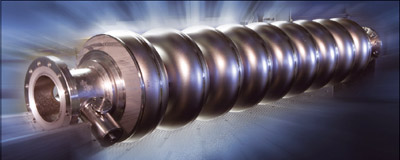
Image credit: Fermilab Visual Media Services.
Free-electron lasers (FELs) based on SRF linacs provide tunable, coherent radiation over a wide range of wavelengths. The Jefferson Lab FEL generates 14 kW of CW laser power in the infrared, with energy recovery by recirculating nearly 1 MW of beam power. This is an important milestone toward the use of energy-recovery linacs (ERLs) for future light sources and electron-cooling applications. SRF-based FELs have operated at the Japan Atomic Energy Research Institute and at the ELBE project in Germany. FLASH at DESY is a short-wavelength FEL based on the self-amplified stimulated emission (SASE) principle, delivering 6 nm wavelength light. Its SRF linac uses more than 60 cavities, each 1 m long to accelerate a 1 GeV electron beam. A variety of innovative linac-based light sources are also under study for FELs and ERLs to deliver orders of magnitude higher brightness and optical beam quality. High-intensity beams for ERLs have spurred explorations for electron-cooling applications and for electron-ion colliders, for example to upgrade the Relativistic Heavy Ion Collider at Brookhaven.
With many exciting prospects on the horizon, the world SRF community has expanded to include many new laboratories where extensive SRF facilities have been installed. In all, more than 1 km of superconducting cavities have been installed worldwide to provide more than 7 GeV of acceleration. The next big jump of 16 GeV is already under construction, with the largest SRF application underway on a superconducting linac for the European XFEL at DESY. It will be based on nearly 700 niobium cavities operating at a gradient of more than 22 MV/m. When completed in 2016 it will provide X-ray beams of unprecedented brilliance at sub-nanometre (Ångström) wavelengths.
A new Facility for Rare Isotope Beams (FRIB) is underway at MSU to allow the study of exotic isotopes related to stellar evolution and the formation of elements in the cosmos. FRIB will be based on more than 330 low-velocity resonators, doubling the number currently in operation.
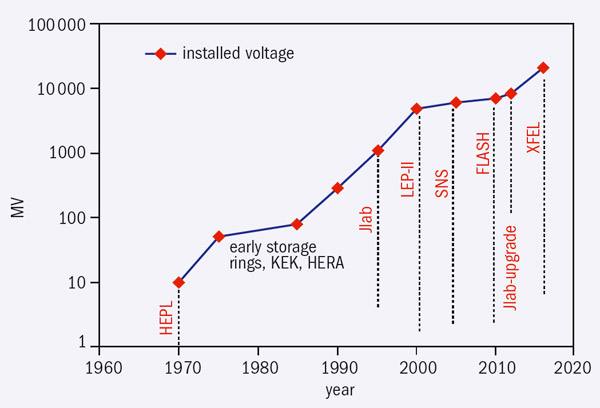
The most ambitious future application under study is for the International Linear Collider (ILC), a 500 GeV superconducting linear accelerator. It will require 16 km of superconducting cavities operating at gradients of 31.5 MV/m. Intense research is underway to reach a high yield for high gradients: 30–40 MV/m. New vendors for niobium, for cavities and for associated components are being developed around the world. Improved techniques for performance reliability and cost reduction are emerging. New assembly and test facilities are coming together at DESY, Saclay, KEK and Fermilab; the experience of the DESY XFEL will be a key stepping stone. Future ILC energy upgrades toward 1 TeV would benefit from even higher gradients that would push niobium towards its ultimate potential of 55 MV/m and thus open the door for new materials with gradients of 100 MV/m. Nb3Sn is the most promising candidate offering the prospect of 100 MV/m gradients, but substantial research is needed to verify this potential and guide the development necessary to harness it.
With the success of the SNS and the upcoming ESS, high-intensity proton linacs are likely to fulfil future needs in a variety of arenas: upgrading injector chains of proton accelerators at Fermilab’s Tevatron (Project X) and CERN’s LHC (the SPL), transmutation applications for treatment of radioactive nuclear waste, nuclear-energy production using thorium fuel, high-intensity neutrino beamlines, high-intensity muon sources for neutrino factories based on muon storage rings and eventually a muon collider at the multi-tera-electron-volt energy scale. All of these far future prospects will of course depend on the success of on-going efforts.
The 2011 International SRF conference in Chicago hosted more than 350 SRF enthusiasts. We can remain confident that the RF superconductivity community has both the creativity and determination to face the upcoming challenges and successfully bring these exciting prospects to fruition.







